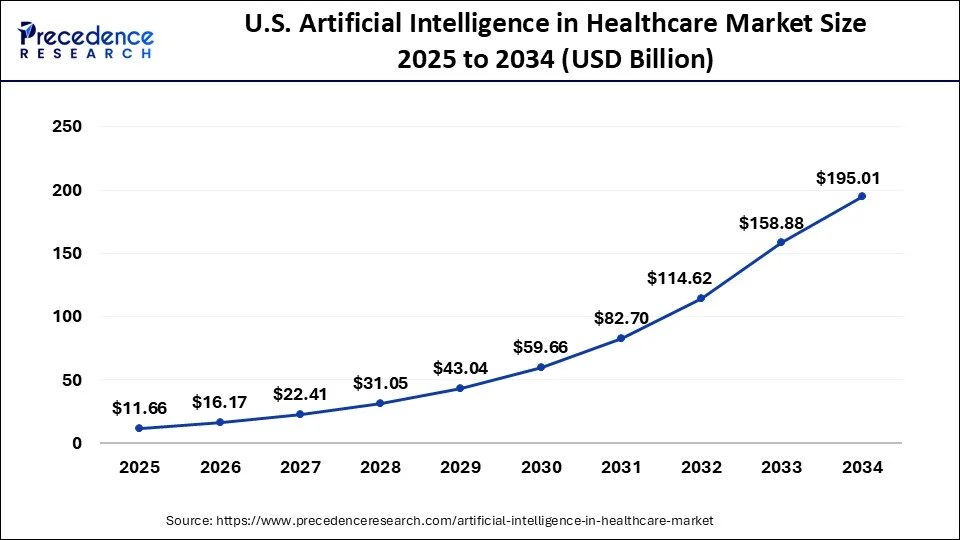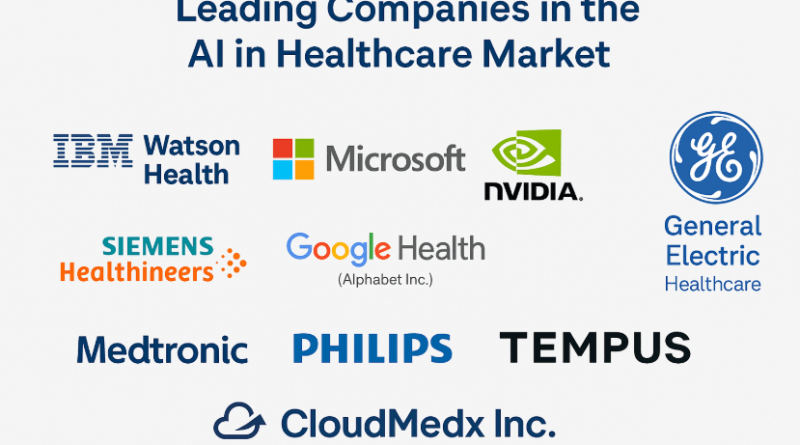Artificial Intelligence in Healthcare Market to Transform Global Care Delivery
According to a recent market analysis by Precedence Research, the global artificial intelligence (AI) in healthcare market size was valued at USD 25.8 billion in 2024 and is forecast to grow at a CAGR of 37.2%, reaching USD 613.81 billion by 2034. This rapid expansion is being powered by the digital transformation of healthcare systems, the growing volume of patient data, and the rising demand for faster, more accurate diagnoses.

Note: This report is readily available for immediate delivery. We can review it with you in a meeting to ensure data reliability and quality for decision-making.
Try Before You Buy – Get the Sample Report@ https://www.precedenceresearch.com/sample/1616
Key Highlights:
-
By component, the software segment dominated the market in 2024 due to increased adoption of AI platforms across clinical workflows and imaging solutions.
-
Machine learning (ML) emerged as the leading technology segment, supporting predictive analytics, clinical decision-making, and automation.
-
Medical imaging & diagnostics accounted for the largest application share, with AI enhancing detection accuracy for conditions like cancer and stroke.
-
North America held the highest market share in 2024, led by the U.S., where healthcare AI investments and digital health startups continue to surge.
-
Asia Pacific is expected to experience the fastest growth, thanks to government-backed health tech initiatives and growing AI talent pools.
AI Is Shaping the Future of Personalized Healthcare
“AI is not just automating healthcare—it’s redefining it,” said a Deepa Pandey, Principal Consultant at Precedence Research. “From predictive diagnostics to robotic surgeries, AI is enabling personalized care at an unprecedented scale while relieving pressure on overburdened systems.”
Drivers Behind the Growth
-
Explosion of Medical Data: Healthcare providers are now sitting on massive data pools—from patient histories to real-time monitoring—making AI essential to extract actionable insights.
-
Rising Need for Cost Efficiency: AI reduces diagnostic errors, automates administrative tasks, and streamlines operations, all while lowering healthcare costs.
-
Accelerated Digital Health Adoption Post-COVID: The pandemic acted as a tipping point for the digitalization of healthcare, fast-tracking AI integration into hospital systems and telemedicine.
-
Breakthroughs in Natural Language Processing (NLP): AI tools can now interpret unstructured medical notes and clinical documentation, aiding physicians and boosting productivity.
Market Scope of AI in Healthcare Market
| Report Details | Statistics |
| Market Size by 2034 | USD 613.81 Billion |
| Market Size in 2025 | USD 36.96 Billion |
| Market Size in 2024 | USD 26.69 Billion |
| Market Growth Rate from 2025 to 2034 | CAGR of 36.83% |
| Largest Market | North America |
| Base Year | 2024 |
| Forecast Period | 2025 to 2034 |
| Segments Covered | Component, Application, Technology, End User, and Regions |
| Regions Covered | North America, Europe, Asia-Pacific, Latin America, and Middle East & Africa |
➡️ Become a valued research partner with us ☎ https://www.precedenceresearch.com/schedule-meeting
AI in Healthcare Market Segmentation Analysis
Which AI components are driving the healthcare transformation?
The software segment is at the heart of AI-driven healthcare transformation, commanding the largest share of the market. Software platforms—including diagnostic tools, clinical decision support systems, and predictive analytics—are being widely adopted in hospitals and research settings. These solutions are enabling faster diagnoses, optimized treatment workflows, and improved patient outcomes.
The rise of cloud-based platforms and AI-as-a-service models has further accelerated software adoption across small- and mid-sized healthcare providers. Meanwhile, the services segment is rapidly growing, with healthcare organizations increasingly relying on implementation, integration, and maintenance services to maximize the value of AI tools.
What role does machine learning play in revolutionizing patient care?
Among the technologies powering AI in healthcare, machine learning (ML) stands out as a game-changer. ML algorithms are capable of analyzing large volumes of data to uncover hidden patterns, predict disease risk, and guide clinical decisions. From identifying tumors in radiology images to predicting patient deterioration in ICUs, machine learning is being embedded across diagnostic and treatment pathways.
Deep learning, a subset of ML, is especially influential in areas like pathology, genomics, and ophthalmology, where high-dimensional image data is common. As the data input quality and volume improve, machine learning models continue to become more accurate and reliable.
Why is AI gaining traction in medical imaging and diagnostics?
AI is making a profound impact on medical imaging and diagnostics, the largest application segment in the market. By enhancing the accuracy and speed of image interpretation, AI is helping radiologists and pathologists detect abnormalities that may be missed by the human eye. For instance, AI algorithms can now identify early signs of cancers, strokes, or fractures in seconds.
Beyond detection, AI assists in image segmentation, annotation, and triaging, significantly reducing radiologist workload and improving workflow efficiency. As imaging datasets grow and become more annotated, this segment is poised for even greater advancements in diagnostic precision.
How is AI redefining clinical decision-making processes?
AI-powered clinical decision support systems (CDSS) are transforming how healthcare professionals diagnose and treat patients. These tools analyze electronic health records (EHRs), lab results, genetic data, and real-time monitoring inputs to offer personalized treatment recommendations.
AI helps clinicians prioritize high-risk patients, predict complications, and avoid unnecessary tests. This not only improves care quality but also reduces medical errors. AI in CDSS is especially valuable in managing chronic diseases like diabetes, heart failure, and COPD, where long-term, data-rich management is essential.
Also Read@ Smart Language Model Market: Transforming the AI Landscape (2025–2034)
AI in Healthcare Market Regional Analysis
Which region is leading the AI healthcare revolution—and why?
North America, particularly the United States, remains the global front-runner in AI adoption in healthcare. The region’s dominance is supported by a robust digital health ecosystem, large-scale R&D investments, and a favorable regulatory environment. Major tech players—including Google, IBM, and Microsoft—are headquartered here and are collaborating extensively with hospitals, startups, and research institutes.
Additionally, U.S.-based healthcare organizations are early adopters of AI for clinical trials, telehealth, and hospital workflow automation. The region’s mature infrastructure and access to high-quality healthcare data further fuel its leadership.
How Big is the U.S. Artificial Intelligence (AI) in Healthcare Market?
According to Precedence Research, the U.S. AI in healthcare market size is calculated at USD 11.66 billion in 2025 and is projected to hit around USD 195.01 billion by 2034, growing at a CAGR of 36.94% from 2025 to 2034.

How is Asia Pacific emerging as a key AI healthcare growth hub?
The Asia Pacific region is witnessing the fastest growth in AI healthcare adoption, with countries like India, China, and Japan investing aggressively in digital health transformation. Government initiatives such as India’s Ayushman Bharat Digital Mission and China’s Health China 2030 aim to modernize healthcare delivery through AI-powered technologies.
Moreover, the region benefits from a vast and diverse patient pool, rising smartphone penetration, and a thriving startup ecosystem. These factors make APAC a prime landscape for testing and scaling AI-driven healthcare solutions—from remote diagnostics to smart hospital automation.
What’s fueling AI integration in European healthcare systems?
In Europe, AI is being integrated into healthcare through public-private partnerships, innovation hubs, and strict but supportive regulatory frameworks. Countries like Germany, the UK, France, and the Netherlands are investing in national AI strategies with a focus on healthcare digitization, clinical trials, and interoperability.
Europe’s emphasis on ethical AI and data privacy (via GDPR compliance) ensures that AI adoption is balanced with patient trust and transparency. In addition, the European Commission’s push for cross-border health data sharing is expected to accelerate AI research and development across the continent.
✅ Get Region-Specific Insights: ✚ Asia Pacific | ✚ North America | ✚ Europe
➤ Contact Us: sales@precedenceresearch.com | ☎ +1 804 441 9344
Who Are the Leading Players in the AI in Healthcare Market—and What Are They Doing?
The competitive landscape of the AI in healthcare market is evolving rapidly, marked by a mix of technological innovation, strategic partnerships, and mergers & acquisitions. Global tech giants, med-tech companies, and specialized startups are competing to bring AI deeper into clinical practice, drug development, and hospital operations.
IBM Watson Health
Once a trailblazer in AI medical diagnostics, IBM Watson Health has pivoted to focus more on enterprise AI solutions and partnerships. Its AI-powered solutions are used in oncology, imaging, and population health management. In 2022, IBM sold parts of Watson Health to investment firm Francisco Partners, which now operates it as Merative, focusing on data-driven healthcare improvement.
Microsoft Corporation
With its powerful Azure AI platform, Microsoft is enabling hospitals and health systems to deploy AI tools across diagnostics, virtual care, and data analytics. Its acquisition of Nuance Communications—a leader in voice-enabled clinical documentation—has positioned Microsoft as a top player in AI-powered physician support tools and EHR automation.
NVIDIA Corporation
NVIDIA is at the forefront of AI computing infrastructure for healthcare. Through its Clara platform, NVIDIA enables developers to build AI applications for medical imaging, genomics, and drug discovery. Its GPUs are powering some of the most advanced AI models used in hospitals and research labs worldwide.
Google Health (Alphabet Inc.)
Backed by DeepMind and Google Cloud, Google Health is working on cutting-edge AI for medical imaging, cancer detection, and population health. Their AI breast cancer detection model, which has shown performance surpassing radiologists in some trials, is a major milestone. Google is also advancing AI-powered EHR search tools to assist clinicians in real-time.
General Electric (GE Healthcare)
GE Healthcare is leveraging AI to improve imaging quality, speed, and accuracy. Its Edison platform integrates AI into radiology workflows, enabling faster diagnoses and predictive maintenance for imaging equipment. GE’s AI tools are widely used across cardiology, neurology, and oncology departments globally.
Siemens Healthineers
Siemens Healthineers offers AI-based diagnostics and imaging tools through its AI-Rad Companion and AI-Pathway Companion. These applications help radiologists interpret complex scans and guide personalized treatment paths. Siemens also integrates AI into its CT, MRI, and ultrasound systems to support faster, more precise clinical decisions.
Medtronic
A leader in medical devices, Medtronic is embedding AI into cardiac monitors, insulin pumps, and surgical navigation systems. The company’s AI-enhanced GI Genius™ module aids in colorectal cancer detection and is FDA-approved. Medtronic’s focus is on combining AI with real-time data to deliver smarter, safer interventions.
Philips Healthcare
Philips is a major player in AI for diagnostic imaging, patient monitoring, and telehealth. Its HealthSuite platform enables hospitals to deploy AI-powered clinical informatics, helping improve operational workflows and care outcomes. Philips is also investing heavily in AI for remote patient monitoring and critical care.
Tempus
Tempus is a precision medicine company specializing in AI-powered genomic and clinical data analytics. Its platform helps oncologists personalize treatment by analyzing patient molecular profiles. Tempus is also building one of the largest libraries of clinical and molecular data to support drug discovery and clinical trials.
CloudMedx Inc.
CloudMedx offers an AI platform that transforms structured and unstructured healthcare data into real-time clinical and operational insights. Its tools are used by payers, providers, and health systems to enhance population health management, predict readmissions, and reduce costs through automation.
The Bigger Picture: Collaboration Is the New Competition
As the AI in healthcare market matures, companies are increasingly partnering rather than going solo. We’re seeing deep collaborations between tech firms and hospitals, pharma companies, academic institutions, and public health organizations. These alliances are essential for training models, gaining access to diverse data, and ensuring regulatory compliance.
Moreover, startups are being acquired or funded at record rates by larger incumbents aiming to fast-track AI adoption. The competitive environment is shifting from product-based differentiation to ecosystem-based value creation.
Source@ https://www.precedenceresearch.com/artificial-intelligence-in-healthcare-market
- Case Study: SABIC – Predictive Maintenance and AI-Driven Operational Excellence - August 19, 2025
- Case Study: BASF – AI-Driven Material Discovery - August 19, 2025
- Artificial Intelligence in Chemicals Market to Surpass USD 28 Billion by 2034 as Digital Twins and Sustainability Drive Transformation - August 19, 2025

